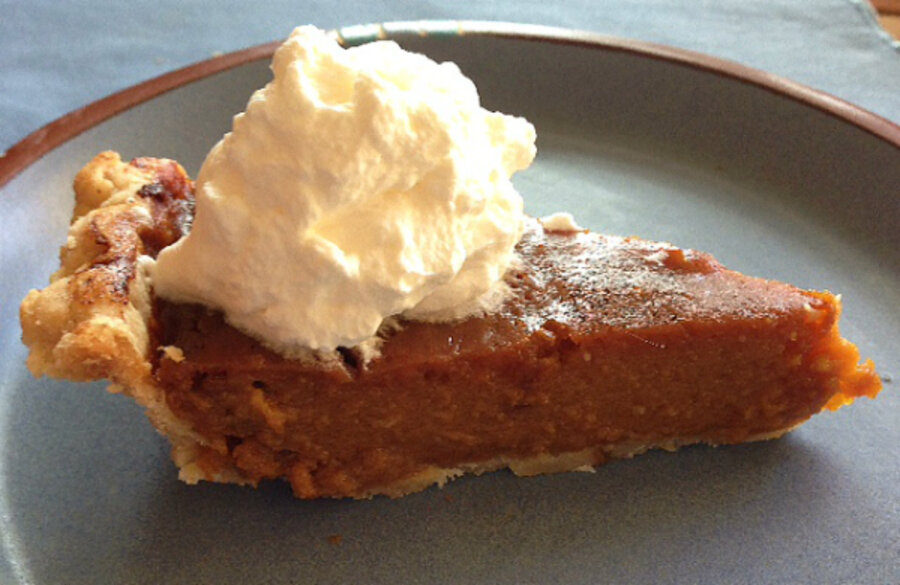Victorian pumpkin pie
Loading...
On most American Thanksgiving tables, pumpkin pie is as much a presence as the turkey centerpiece. In modern forms it may appear as a flan, a cheesecake, or a frozen whipped delight.
In a Victorian-era cookbook, “The Art of Cookery: A Manual for Home and Schools” by Emma P Ewing, I found a recipe for a pumpkin pie that surprised me for two reasons: the heavy use of molasses and no cinnamon.
The cookbook belonged to Minnie P. Weygandt, the cook for Mary Baker Eddy, the founder of The Christian Science Monitor. Minnie had inscribed her name, the date (Aug. 24, 1899), and the place, “Pleasant View,” Concord, N.H., in the flyleaf. Pleasant View was the home of Eddy at the turn of the 19th century and one can assume that Minnie used this cooking guide quite a bit as she prepared meals for at least a dozen people.
Being a cook for a large household in the late 1800s was no easy task.
“When I was cooking for Mrs. Eddy then we did not have the convenience of a gas stove,” writes Minnie in her reminiscences that can be found in the archives of The Mary Baker Eddy Library in Boston. “All the cooking was done on a very small coal range, which was later supplemented by a two burner gas plate kept on the end of the stove. Many times we worked over that inadequate stove until eleven and twelve at night during the canning and preserving season.” (p. 40)
That sounds like a nightmare.
As it was close to Thanksgiving when I asked the Mary Baker Eddy Library staff to bring me Minnie’s copy of “The Art of Cookery” from the archives, I naturally looked up the recipe for pumpkin pie.
I have pointed out before, molasses was a common ingredient in early New England cooking. And the use of molasses in pumpkin pie gives it a much richer, browner color.
Cinnamon, nutmeg, all spice, or even pumpin pie spice is not present at all in this simple version of pumpkin pie. I was a little skeptical that I had copied the recipe down wrong when I saw “1 tablespoon ginger” in my notes, but I followed through. As most early recipes do not provide oven temperatures, considering the wide range of stoves in use, the recipe simply instructed, “Bake until pie is brown in the center.”
I consulted a couple of other cookbooks to come up with a satisfactory oven temperature, and used a knife test just to be sure the pie was finished after it had cooked for nearly an hour.
If you are not a huge fan of pumpkin pie, you may prefer this version. The molasses cloaks the pumpkin flavor and the absence of cinnamon may trick your taste memories away from declaring,”Oh, I’m eating pumpkin pie. It must be Thanksgiving.” The ginger is not overpowering at all, and a smooth finish of whipped cream pairs very nicely with the molasses flavor.
With the arrival of Libby’s canned pumpkin in 1929, came the annual tradition of baking a Thanksgiving pumpkin pie with cinnamon, ginger, and cloves. Molasses got the boot.
This earlier version calls for stewed pumpkin. I ended up roasting my pumpkin before puréeing it. You’ll also want to let it sit in a sieve for a few minutes to let the extra juices run out.
Victorian pumpkin pie may not be as fashionable as mini pumpkin flans swimming in caramel sauce, but if you show up at Thanksgiving dinner offering one of these, you’ll be so retro you’ll be hip.
Victorian pumpkin pie
2 cups stewed pumpkin purée
1 cup rich sweet milk (I used sweet condensed milk)
1/2 cup molasses
1/2 cup sugar
1 tablespoon melted butter
1 tablespoon ginger
1 teaspoon salt
2 eggs, beaten lightly
Sift flour over bottom of pie shell. Bake until pie is brown in center. (I started the oven at 425 degrees F. for 10 minutes, then reduced the heat to 325 degrees F. and baked for 45 minutes. When a knife inserted near the center came out clean, it was done. Cool on wire rack for 2 hours. Serve immediately with whipped cream or refrigerate.)
This post is part of the First Saturday program at The Mary Baker Eddy Library, which is sponsoring a month-long look at 19th-century foodways.






